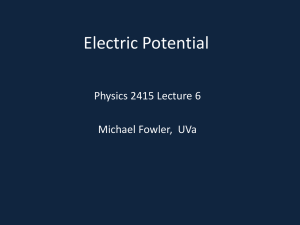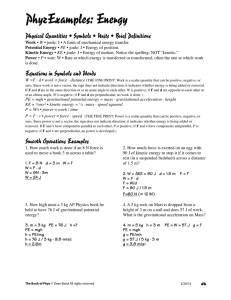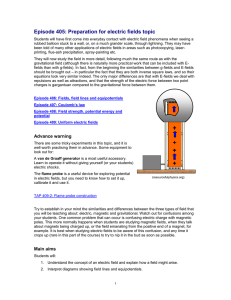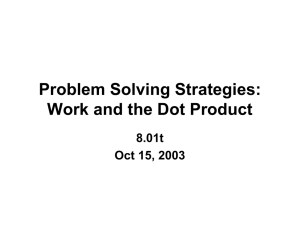Physics 1425: General Physics I
advertisement
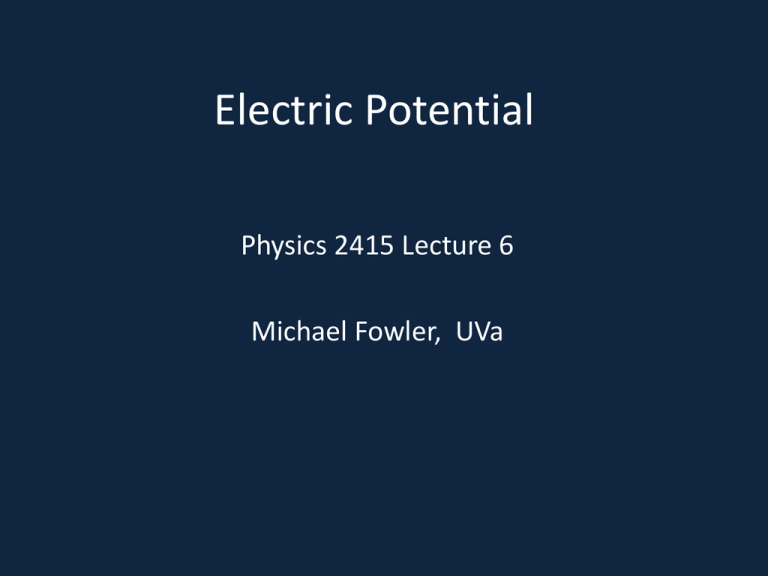
Electric Potential Physics 2415 Lecture 6 Michael Fowler, UVa Today’s Topics • Some reminders about gravity: mgh and its electric cousin • Inverse square law and its potential • Field lines and equipotentials Lifting a Rock • Near the Earth’s surface, the gravitational field vector points vertically down, and has constant magnitude g, the force on a mass m is F mg. • The work done in lifting mass m through height h is mgh: this is the potential energy. • a g F mg h ground Lifting a Rock • The work done in lifting mass m through height h is mgh: this is the potential energy—defined to be zero at ground level, but could take some other level as zero, only differences of potential energy matter. • The PE per unit mass, gh, is called the (gravitational) potential. • a g F mg h ground Lifting a Rock along a Wavy Path • Suppose we lift up the heavy rock erratically, following the wavy green path shown. Our work against gravity only involves the component of the gravitational force pointing along the path: • a g b F mg b W mg d h a • Or, equally, only the upward component of d counts, and W = mgh. a ground Electric Potential of a Negative Sheet • Imagine an infinite sheet of negative charge, C/m2. • On either side of the sheet there is a uniform electric field, strength E / 2 0 , directed towards the sheet. • To move a + charge q from the sheet distance z takes work qEz. • The electric potential difference V z V 0 Ez z / 2 0 and this x q becomes KE if the charge is “dropped” to the sheet. • a E charge q F qE z negatively charged infinite sheet Potential, Potential Difference and Work • We’ve seen that the electric field of a uniform infinite sheet of negative charge is constant, like the Earth’s gravitational field near its surface. • Just as a gravitational potential difference can be defined as work needed per unit mass to move from one place to another, electric potential difference is work needed per unit charge to go from a to b, say. • The standard unit is: 1 volt = 1 joule/coulomb Potential Energy of a Charge Near an Infinite Plane of Negative Charge a Plane of negative Charge (perpendicular to screen) PE qV(z) for a positive charge 0 z PE qV(z) for a negative charge Electric Field and Potential between Two Plates Having Opposite Charge • Separation d is small compared with the • a size of the plates, which carry uniform charge densities . • The electric force on a unit charge between the plates E / 0 N/Coul. • The voltage (potential difference) between the plates is the work needed to take unit charge from one to the other, V Ed • Note from this that E can be expressed in volts/meter. d E / 0 Units for Electric Potential and Field • Potential is measured in volts, to raise the potential of a one coulomb charge by one volt takes one joule of work: • One volt = one joule per coulomb • An electric field exerts a force on a charge, measured in newtons per coulomb. • Since one joule = one newton x one meter, electric field is equivalently measured in volts per meter. Review from Phys 1425 Lec 14 Gravitational Potential Energy… 0 • A • …on a bigger scale! • For a mass m lifted to a point r from the Earth’s center, far above the Earth’s surface, the work done to lift it is r 1 1 GMm W 2 dr GMm . r rE r rE • If r = rE + h, with h small, r rE GMmh W GMm mgh. 2 rrE rE rE r U(r) = -GMm/r In astronomy, the custom is to take the zero of gravitational potential energy at infinity instead of at the Earth’s surface. Electric Potential Outside a Uniformly Charged Spherical Shell • Recall the electric field is 1 Qrˆ E r 4 0 r 2 precisely the same form as in gravitation—except this points outwards! • Therefore the PE must also have the same form— taking it zero at infinity, 1 Q V r 4 0 r • a V(r) 0 r0 r Electric Potential Inside a Uniformly Charged Spherical Shell • The electric field inside a spherical shell is zero everywhere—so it takes zero work to move a charge around. The gravity analog is a flat surface: the potential is constant—but not zero, equal to its value at the surface: 1 Q V r for r r0 4 0 r0 • a V(r) 0 r0 r Potential Outside any Spherically Symmetric Charge Distribution • We’ve shown that for a uniform spherical shell of charge the field outside is 1 Q V r 4 0 r • Any spherically symmetric charge distribution can be built of shells, so this formula is true outside any such distribution, with Q now the total charge. • It’s true even for a point charge, which can be regarded as a tiny sphere. Potential Energy Hill to Ionize Hydrogen • The proton has charge +1.6x10-19C, giving rise to a potential 19 1 Q 1.6 10 9 V r 9 10 4 0 r r • Taking the Bohr model for the ground state of the H atom, the electron circles at a radius of 0.53x10-10m, at which V(r) = 27.2 V. • The natural energy unit here is the electron volt : the work needed to take one electron from rest up a one volt hill. But in H the electron already has KE = 13.6eV, so only another 13.6eV is needed for escape. Potential Energy Hill for Nuclear Fusion • If two deuterium nuclei are brought close enough, the attractive nuclear force snaps them together with a big release of energy. • This could solve the energy problem—but it’s hard to get them close enough, meaning about 10-15m apart. • Each nucleus carries positive charge e, so 19 1 Q 1.6 10 6 V r 9 109 10 eV 15 4 0 r 2 10 • This is the problem with fusion energy… Potential Energies Just Add • Suppose you want to bring one charge Q close to two other fixed charges: Q1 and Q2. • The electric field Q feels is the sum of the two fields from Q1, Q2, the work done in moving d is • a y Q V r V1 r V2 r Q1 r r2 E d E1 d E2 d so since the potential energy change along a path is work done, r1 Q2 0 x 1 Q1 Q2 V r 4 0 r1 r2 Equipotentials • Gravitational equipotentials are just contour lines: lines connecting points (x,y) at the same height. (Remember PE = mgh.) • It takes no work against gravity to move along a contour line. • Question: What is the significance of contour lines crowding together? Electric Equipotentials: Point Charge • The potential from a point charge Q is 1 Q V r 4 0 r • Obviously, equipotentials are surfaces of constant r: that is, spheres centered at the charge. • In fact, this is also true for gravitation—the map contour lines represent where these spheres meet the Earth’s surface. Plotting Equipotentials • Equipotentials are surfaces in three dimensional space—we can’t draw them very well. We have to settle for a two dimensional slice. • Check out the representations here.
